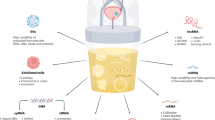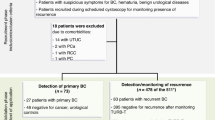Abstract
A reliable, noninvasive method for monitoring patients with transitional cell carcinoma (TCC) of the bladder would be of great clinical benefit. Cystoscopy is currently the “gold standard,” but it is invasive, expensive and uncomfortable for the patient. Recently, we demonstrated a novel approach for the detection of primary bladder cancer based on microsatellite analysis of urine DNA. To determine the feasibility of this technique for following-up patients with TCC, we tested serial urine samples from 21 patients who had been treated for bladder cancer with 20 polymorphic microsatellite markers in a blinded fashion. We detected recurrent lesions in 10 out of 11 patients and correctly predicted the existence of a neoplastic cell population in the urine of two patients, 4 and 6 months before cystoscopic evidence of the tumor. The assay was negative in 10 of 10 patients who had no evident cancer. Microsatellite analysis of urine sediment represents a novel and potentially powerful clinical tool for the detection of recurrent bladder cancer.
This is a preview of subscription content, access via your institution
Access options
Subscribe to this journal
Receive 12 print issues and online access
$209.00 per year
only $17.42 per issue
Buy this article
- Purchase on Springer Link
- Instant access to full article PDF
Prices may be subject to local taxes which are calculated during checkout
Similar content being viewed by others
References
Boring, C.C., Squires, T.S. Tong, T. & Montgomery, S. Cancer statistics, 1994. CA Cancer J. Clin. 44, 7–26 (1994).
Hudson, M.A. & Catalona, W.J. Urothelial tumors of the bladder, upper tracts and prostate. in Adult and Pediatric Urology, (eds. Gillenwater, J.Y., Grayhack, J.T., Howards, S.S., Duckett, J.W.) 643–694 (Mosby, St. Louis, MO, A1996).
Papanicolaou, G.N. & Marshall, V.F. Urine sediment smears as a diagnostic procedure in cancers of the urinary tract. Science 101, 519–520 (1945).
Murphy, W.M., Soloway, M.S., Jukkola, A.F., Crabtree, W.N. & Ford, K.S. Urinary cytology and bladder cancer: The cellular features of transitional cell neoplasms. Cancer 53, 1555–1565 (1984).
Sarosdy, M.F. et al. Results of a multicenter trial using the BTA test to monitor for and diagnose recurrent bladder cancer. J. Urol. 154, 379–384 (1995).
Soloway, M.S. et al. Use of a new tumor marker, NMP22 in the detection of occult or rapidly recurring transitional cell carcinoma of the urinary tract following surgical treatment. J. Urol. 156, 363–367 (1996).
Mao, L. et al. Molecular detection of primary bladder cancer by microsatellite analysis. Science 271, 659–663 (1996).
Fisher, D.E. Apoptosis in cancer therapy: CFossing the threshold. Cell 78, 539–542 (1994).
Rouslahti, E. & Reed J.C. Anchorage dependence, integrins, and apoptosis. Cell 77, 477–478 (1994).
Loh, C.S., Speeding, A.V., Ashworth, M.T., Kenyon, W.E. & Desmond, A.D. The value of exfoliative urine cytology in combination with flexible cystoscopy in the diagnosis of recurrent transitional cell carcinoma of the urinary bladder. Br. J. Urol. 77, 655–658 (1996).
Cutler, S.J., Heney, N.M. & Friedell, G.H. Longitudinal study of patients with bladder cancer: Factors associated with disease recurrence and progression. AUA Monographs, (ed. Bonney, W. & Brout, G.) p. 35 (Williams & Wilkins, Baltimore, MD, 1982).
Hruban, R.H., van der Riet, P., Erozan, Y.S. & Sidransky, D. Molecular biology and the early detection of carcinoma of the bladder: The case of Hubert Horatio Humphrey. N. Engl. J. Med. 330, 1276–1278 (1994).
Mao, L., Hruban, R.H., Boyle, J.O., Tockman, M. & Sidransky, D. Detection of onco-gene mutations in sputum precedes diagnosis of lung cancer. Cancer Res. 54, 1634–1637 (1994).
Wang, Y. et al. Microsatellite-based cancer detection using capillary array electrophoresis and energy-transfer fluorescent primers. J. Electrophoresis (in the press).
American Joint Committee on Cancer. Manual for Staging of Cancer, 3rd edn. 171–176 (Lippincott, Philadelphia, PA, 1988).
The Genome Database, the William H. Welch Library, the Johns Hopkins University, Baltimore, MD. Accessible through the Internet at http://gdbwww.gdb.org/.
Author information
Authors and Affiliations
Rights and permissions
About this article
Cite this article
Steiner, G., Schoenberg, M., Linn, J. et al. Detection of bladder cancer recurrence by microsatellite analysis of urine. Nat Med 3, 621–624 (1997). https://doi.org/10.1038/nm0697-621
Received:
Accepted:
Issue Date:
DOI: https://doi.org/10.1038/nm0697-621
This article is cited by
-
Prognostic relevance of positive urine markers in patients with negative cystoscopy during surveillance of bladder cancer
BMC Cancer (2015)
-
Urinzytologie – Update 2013
Der Urologe (2013)
-
Microsatellite instability analysis in uterine cavity washings as a screening tool for endometrial cancer in Lynch syndrome
Familial Cancer (2011)
-
Charakterisierung von DNA-Methylierungs-Biomarkern für das Harnblasenkarzinom
Der Pathologe (2010)



